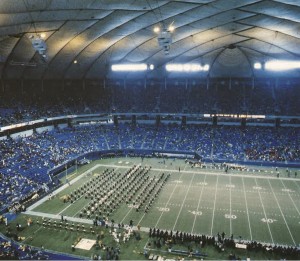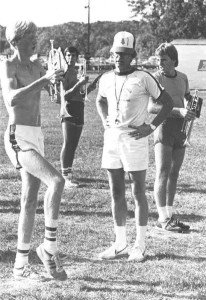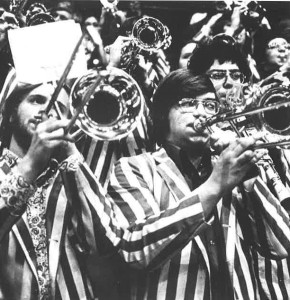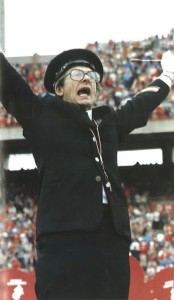A commercial that turned into a toe-tapping anthem for loyal Badger fans
The Fifth Quarter
Stop at the top
Zahh!
“Eat a rock”
The tap step
Knee bows
A gigantic pep band concert
To any former band member, the list above needs no explanation. These are some of the innovations, ideas, and expressions brought to the Wisconsin Band by Michael Leckrone.
When Leckrone arrived on the Madison campus in the late summer of 1969, interest in the marching band was at an all-time low. The causes for that predicament were varied. Leckrone was to be the third marching band director in a three-year span. Consequently, veteran band members had experienced very little community, stability, or loyalty to a specific program. Moreover, the Wisconsin football team was in the throes of a horrendous 22-game losing streak, in which they had not won a game and Saturday afternoon in Camp Randall had lost a great deal of fun. As if these reasons were not enough, from 1968 to about 1971 campuses all across the nation were experiencing a period of unrest and protest. Wearing a uniform and marching around in a military manner was hardly a popular activity among young people at that time, and band enrollments were suffering everywhere. Nevertheless, Leckrone approached the task ahead of him with enthusiasm, energy, and several new ideas.
That first year Leckrone began to instill in the band members his concept of intense physical conditioning. He insisted that every prospective band member, veteran and freshman alike, should attend the Registration Week fundamental drills. The men that made up those early marching bands soon discovered that these drills strongly resembled the training camp of a championship athletic team. He initiated a more demanding marching stride, provided a new emphasis on showmanship, re-designed the pre-game entrance, decreed that the marching band should be a 100 percent volunteer organization, but most important he let it be known that he expected marching band to be fun.
Most of the changes in the first year were met with success, although a few of the veterans grumbled about the intensity that this new crew-cutted drill sergeant was demanding of them. The roster of that band lists 110 names, although in performance the band varied from 96-104 members. Leckrone did stir up a minor controversy that first year when he announced that the role of pom-pom squad would be greatly diminished in all future marching band performances. The squad had been accustomed to presenting a routine at every pre-game and every halftime show. The Madison press and the Badger Herald took exception to this announcement and objected to the “harsh treatment” the girls had received as a result. One squad member was quoted as saying, “Leckrone has let it be known in no uncertain terms that he doesn’t even want a pom-pom squad.” A number of the pom-pom girls publicly denounced the “monster” that was now directing the marching band. The matter was settled in a degree of compromise when Leckrone and the athletic department agreed on a procedure that would allow one short routine each pre-game performance for the remainder of the 1969 season, with the understanding that in future years the pom-pom squad would perform on the field only after the marching band had vacated it. Leckrone promised full support for musical accompaniments of future routines, as long as they were scheduled after the band had concluded its performance. The initial show of Leckrone’s first season was, appropriately enough, a salute to new athletic director Elroy Hirsch. That first performance gave fans a hint of what to expect in future Leckrone productions. It was fast-paced, varied, and unpredictable. According to Leckrone,“I basically have always patterned my shows around the concept of the old Ed Sullivan Television Show. The most important thing the Sullivan Show had going for it was variety. If you didn’t like an act that Ed introduced, you know that in a minute or two, there would be something entirely different.”
The band soon learned that they were to have a mission: the search for excellence. Leckrone ordered that motion pictures be taken of every game and scheduled viewing sessions in which he pointed out errors and inconsistency in the band’s performance. This soon led to a published list of each performer’s error that had been noticed. This list was posted on the band bulletin board following every game. Naturally, no one wanted to see his or her name on the list, and soon it was given a name that has stood to this writing: “The Dummy List.”
Leckrone attempted to solve another long-standing band department problem during his first year. He organized a group that was to be called the Varsity Band. For several years prior to 1969, there had been much concern over the manner in which music would be provided for the Badger basketball games and an occasional hockey game. Traditionally, such duties had been divided by the groups called the Badger Band and the Cardinal Band. This often led to some confusion and detracted from the concert preparation of both groups. Therefore, this special organization was formed solely for the purpose of providing music, spirit, and enthusiasm at Wisconsin athletic events. The band was an immediate hit. They performed a widely varied repertoire, wore classy red and white striped jackets came up with a number of clever cheers, and continually demonstrated an infectious spirit. There were 27 men in that first Varsity Band.

In 1970, band enrollment jumped to 147 members, and the size of the band was standardized for every performance at 120. It was in 1970 that Leckrone arrived at the pre-game run-on format, which has been maintained to the present. It was also that year that the incident occurred that Leckrone and all the members of that band refer to as “the turning point for the ‘new’ Wisconsin Band.” That year a trip had been planned that would take the band to Indiana University and allow the former Hoosier to return to his home state for the first time since he had become a Badger. The first leg of the trip took the band to Indianapolis, and on Saturday an early morning bus ride was made from Indianapolis to Bloomington. After getting off the buses at the Indiana campus the band proceeded to produce a rehearsal that has since been called the “worse rehearsal in the history of the Wisconsin Band.” It seemed that a large number of the band members got little or no sleep in Indianapolis the previous night, and the mental alertness was at a zero level. Players were turning on the wrong yard line, missing halts, and running into each other. About half way through the rehearsal, Leckrone had had enough. “That’s it, I can’t stand it anymore, off the field!” The rehearsal was over. In the two hours between the rehearsal and game time, there was a great deal of talk among the band members about pride, esprit de corps, and about giving 100 percent. With a “win one for the Gipper” attitude, the 1970 Wisconsin Band went on the field at Indiana and presented a sensational performance that was met with a standing ovation from the normally sedate Indiana fans. At that point a standard of performance was set, and the Wisconsin Marching Band began an extraordinary period of growth.
1972-73 became another banner year for the Wisconsin Band. The marching band proudly displayed 16 new brass sousaphones and 150 newly designed, uniforms. Both the sousaphones and the uniforms were purchased through the efforts of Robert Rennebohm and the UW Foundation. Rufus “The Roadrunner” Ferguson was bringing record crowds to Camp Randall for every game, and the band “brought the house down” in a show called “The Eyes Have It” when all the 120 musicians executed a near perfect version of the “Rufus Shuffle.” The trip that season was the East Lansing, Michigan, where the uniforms were initiated in a driving rainstorm. In the spring of that year 60 Varsity Band members experienced the thrill of a lifetime when they accompanied the Badger hockey team to the Boston Gardens and witnessed history. In two emotion-packed games the Badgers came from behind and won their first NCAA Championship. It was at that event that You’ve Said It All (The Bud Song) became a Wisconsin hockey tradition.
The band continued to grow from 160 members in 1973, to 170 in 1974, and jumped up to 204 in 1975. As enrollment increased so did the number of activities and performances. More and more campus events were being supplied with music by the Band and in 1974 the Wisconsin Band made their first appearance at a professional football game in Soldier Field as they provided the halftime performance for the Chicago Bears – Green Bay Packers game.
The most significant event to occur in 1974-75 was the addition of women to the marching band. After 89 years of being an all male organization, the band became “co-ed” for the first time in history. In 1971 the band department had removed the qualifications for marching bands which had previously read “Open to all male students.” Nevertheless, prior to 1974 there were no serious inquiries about membership by female students. It is curious to note that the Wisconsin Band was one of the first bands in the Big Ten to remove the all male qualifications, but was the last band to add women to its membership. Because the transition was handled so smoothly, the press was caught somewhat off guard in reporting occurrence. However, they more than made up for it in the weeks that followed. The two women who were placed in this historic position, Paula Schultz (trumpet) and Mary Ann Thurber (saxophone), easily fit into the traditions and procedures of the band. They were quickly accepted, and both women seemed much more concerned with improving themselves and the organization than in the publicity which their break-through had created.
The gender barrier had been broken, and in ensuing years the number of women trying out for the marching band slowly increased. In the spring of that same school year, a new tradition began. On March 21, 1975, the First Annual Varsity Band Concert was presented in Mills Concert Hall to an unexpectedly large audience of about 450 friends, parents, and fans. In the beginning, the purpose for presenting a Varsity Band Concert was little more than a social one. Director Mike Leckrone felt that there should be one performance at the end of the year in which all the members of the Varsity Band would be able to get together, play a few of their favorite arrangements for an interested audience, and then have a party. Those purposes remained basically unchanged for the Second Annual Spring Concert; however, this time Mills Hall was packed. Every seat was taken and dozens of listeners crowded the aisles. Before the evening was completed, there was not even “standing room” space available. The concert had reached the attention and gained the support of sportswriters, particularly Glenn Miller of the Wisconsin State Journal, and the broadcasters, namely Phil Mendel of the Dane County Coliseum. Interest was so high that the third concert was scheduled for the Fieldhouse. For that performance the band was set up in the middle of the basketball floor and performed to approximately 2,800 fans in the west stands. The audience continued to grow and the band kept moving east until eventually a stage was erected so every seat in the Fieldhouse could be sold. In 1979 the first sell-out was recorded. At that time there was no reserved seating. The audience began lining up at the door hours before the concert and within fifteen minutes of the doors opening every seat was occupied. The event itself evolved from that first, very informal presentation, which Leckrone announced the program to the band just prior to going on stage. In addition to sophisticated lighting, pyrotechnics, explosions, video back projections, circus acts, monsters, gigantic gongs, slide shows, fireworks, lightning machines, lasers, and plenty of surprises, the event has included guest stars such as Rich Richelieu-the Banjo King, Doc DeHaven and his band, baritone Jonathan Lee Overby, Little Vito and the Torpedoes, and Tom Wopat-the star of television’s “D Hazzard,” and former student at the University. Each year, 9, 500 tickets are sold out within two or three days. Reviewers and critics have been most enthusiastic. WHA-TV carries the concert in its entirety throughout the state.
Shortly after that first Varsity Band Concert, Reynolds announced his resignation as director of bands at Wisconsin, and Leckrone was given responsibility for the administration of the band department and the title Director of Bands.
During the next several seasons, the band continued to grow and each year seemed to bring something new, something different, and something exciting for the band members to experience. They witnessed another Badger championship at the NCAA Hockey Tournament in Detroit (1977), the band was the subject of an Associated Press story which was carried in newspapers from coast to coast (1977), “The Gong Show” was presented in Camp Randall, the crowd went wild when the Big Red Band placed paper bags over their heads and became the “Unknown Band,” the band and the Wisconsin fans overwhelmed the City of Providence at the NCAA Hockey Tournament even though the Badgers lost (1978), and this in turn evolved into the now famous post-game performance that has been designated “The Fifth Quarter” (1978). That same year the band enrollment reached 240, and the performance block was established at 200. The size which has continued to increase, with well over 350 students trying out for the band each year.
In the fall of 1980 the band department was informed that their long-time practice field next to the Natatorium was to become a part of the new School of Veterinary Medicine. Immediately, committees were formed to find a new site for the band’s practice field. After several weeks of wrangling, the band was granted the use of a practice site adjacent to the Walnut Street running track as well as a field west of the Natatorium near Lot 60. Plans were also formulated for a building to be constructed on the site for storage of instruments and shelter.
1981 was also the first time in 18 years that Wisconsin football did not end in November. It was announced that the Badgers had been chosen to play a post-season game in Giants Stadium against the Tennessee Volunteers. The band began preparing for a performance at the Garden State Bowl. Enthusiasm for the trip increased rapidly when the band members realized they would be spending part of the time in New York City. When he discovered the band was to be housed in the same hotel as the team, government officials, and the official Wisconsin Party, Leckrone decreed, “there will be no problems!” And that became the watchword for the entire weekend. Perhaps the most vivid memory of the trip was the expression fixed on the faces of the bundled-up, shivering Tennessee Band as they watched a short-sleeved, shorts-clad Badger Band rehearse on a field covered with snow. At that moment they knew they had no chance. The game was won by Tennessee, but the Badger Band dominated the day.
In May 1986, a special Varsity Band Concert was performed in Camp Randall. This event concluded the first 100 years of the Band, as well as skyrocketed them forward into an even more rewarding and spectacular second 100 years.
Early in the spring of 1993 two announcements brought additional recognition to the Wisconsin Band. Playboy Magazine, after surveying the best and worst of college life on campuses all over the United States, named the Wisconsin Band the #1 band in the nation. Not to be outdone, the UW Foundation indicated they would be initiating a fund raising drive to establish a 3.5 million dollar endowment for the band. The “Spirit of Wisconsin Campaign” would provide funds for uniforms, instruments, travel and scholarships. Those funds would enable future bands to remain one of the best equipped college organizations in the nation. Much of the momentum for the campaign was provided by UW alumni Jim Burt and Jere Fluno.
The Wisconsin Band, under the direction of Leckrone, has continued to perform to sell-out crowds in performances ranging from Camp Randall and the Kohl Center to Lambeau Field, Rose Bowls, numerous other Bowl games, and the Final Four Basketball Tournament in Indianapolis.
In the immortal words of Leckrone:
“If it was easy, anybody could do it.”
“I don’t want excuses, I want results.”
“My strength is the strength of 10 because my heart is pure.”
“I’d like to think that the tuba section is one of the finest in the country. They’re not, but I’d like to think that.”
“When you’re in the Wisconsin Band, you’ve got to be tough enough to eat a rock.”
“Some are born great, some achieve greatness, and some others have greatness thrust upon them. Choose one of the above.”
“They are able who think they are able. Those who are not able had better get there.”
“Genius does what it must and talent does what it can. You guys do what you can, I’ll do what I must.”
“When that one great scorer comes to write against your name, he marks not that you won or lost, but how you performed at half-time!”
“If there’s anything I can’t stand, it’s a band that sounds like somebody laid a blanket over them and they’re sweating.”
“Don’t do what I say, do what I think!”
“You can always take pain as long as you know when it will end.”
“You can’t catch cold from exposure.”
and most importantly: “When You Say ‘Wisconsin,’ You’ve Said It All!”




